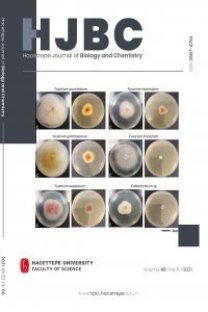İç Anadolu’daki Tuz Gölü’nden İzole Edilen Çeşitli Halofilik Bakterilerdeki Quorum Sensing Sistemine Yeni Bir Yaklaşım
A New Approach for Quorum Sensing System in Several Halophilic Bacteria Isolated from Salt Lake in Central Anatolia
___
- M.P. Schultz, J.A. Bendick, E.R. Holm, W.M. Hertel, Economic impact of biofouling on a naval surface ship, Biofouling., 27 (2011) 87-98.
- A. Kılıç, E. Uyanık, Tuz Gölü’nde oluşan kirlenmenin göl üzerindeki etkilerinin araştırılması, 4. Endüstriyel Hammaddeler Sempozyumu 18-19 Ekim, (2001) 135- 145.
- K. Montgomery, J.C. Charlesworth, R. Lebard, P.T. Visscher, B.P. Burns, Quorum Sensing in Extreme Environments, Life, 3 (2013) 131-148.
- H.P. Steenackers, I. Parijs, K.R. Foster, J. Vanderleyden, Experimental evolution in biofilm populations, FEMS Microbiol. Rev., 40 (2016) 373-397.
- B.A. Doğaner, L.K. Yan, H. Youk, Autocrine signaling and quorum sensing: Extreme ends of a common spectrum, Trends Cell Biol., 26 (2016) 262-271.
- A. Tahrioui, M. Schwab, E. Quesada, I. Llamas, Quorum sensing in some representative species of halomonadaceae, Life (Basel), 3 (2013) 260-75.
- R. Rohban, M.A. Amoozegar, A. Ventosa, Screening and isolation of halophilic bacteria producing extracellular hydrolyses from Howz Soltan Lake, Iran, J. Ind. Microbiol. Biotechnol., 36 (2009) 333-340.
- S.B. McGee, C.A. Orengo, M.E. Kunik, V.A. Molinari, R.H. Workman, Delirium in geropsychiatric patients: patient characteristics and treatment outcomes, J. Geriatr. Psychiatry Neurol., 10 (1997) 7-10.
- M. Le Chevanton, M. Garnier, G. Bougaran, N. Schreiber, E. Lukomska, J.B. Bérard, E. Fouilland, O. Bernard, J.P. Cadoret, Screening and selection of growth-promoting bacteria for Dunaliella cultures, Algal Res., 2 (2013) 212-222.
- A. Tahrioui, E. Quesada, I. Llamas, The hanR/hanI quorum-sensing system of Halomonas anticariensis, a moder-ately halophilic bacterium, Microbiology, 157 (2011) 3378-87.
- J. Liu, A.J. Lewitus, P. Brown, S.B. Wilde, Growthpromoting effects of a bacterium on raphidophytes and other phytoplankton, Harmful Algae, 7 (2008) 1-10.
- C. Sánchez‐Porro, S. Martin, E. Mellado, A. Ventosa, Diversity of moderately halophilic bacteria producing extra-cellular hydrolytic enzymes, J. Appl. Microbiol., 94 (2003) 295-300.
- X. Wang, J.F. Preston, T. Romeo, The pgaABCD locus of Escherichia coli promotes the synthesis of a polysaccha-ride adhesin required for biofilm formation, J. Bacteriol., 186 (2004) 2724-2734.
- D. Mack, W. Fischer, A. Krokotsch, K. Leopold, R. Hartmann, H. Egge, R. Laufs, The intercellular adhesin in-volved in biofilm accumulation of Staphylococcus epidermidis is a linear beta-1, 6-linked glucosaminoglycan: purification and structural analysis. J. Bacteriol., 178 (1996) 175-183.
- S.D. Saroj, P.N. Rather, Streptomycin inhibits quorum sensing in Acinetobacter baumannii, Antimicrob. Agents Chemother., 57 (2013) 1926-1929.
- J.H. Merritt, D.E. Kadouri, G.A. O’Toole, Growing and analyzing static biofilms, Curr. Protoc. Microbiol., Chapter 1 (2005) Unit 1B.1.
- D. Anbazhagan, M. Mansor, G.O. Yan, M.Y. Md Yusof, H. Hassan, S.D. Sekaran, Detection of quorum sensing sig-nal molecules and identification of an autoinducer synthase gene among biofilm forming clinical isolates of Acinetobacter spp, PloS one, 7 (2012)
- R.H. González, A. Nusblat, B.C. Nudel, Detection and characterization of quorum sensing signal molecules in Acinetobacter strains, Microbiol. Res., 155 (2001) 271-277.
- H. Lade, D. Paul, J.H. Kweon, Isolation and molecular characterization of biofouling bacteria and profiling of quorum sensing signal molecules from membrane bioreactor activated sludge, Int. J. Mol. Sci., 15 (2014) 2255-2273.
- V.A. Blana, G.J. Nychas, Presence of quorum sensing signal molecules in minced beef stored under various tem-perature and packaging conditions, Int. J. Food. Microbiol., 173 (2014) 1-8.
- M.M. Marketon, M.R. Gronquist, A. Eberhard, J.E. Gonzalez, Characterization of the Sinorhizobium meliloti sinR/sinI locus and the production of novel N-acyl homoserine lactones, J. Bacteriol., 184(2002) 5686-5695.
- M.M. Marketon, J.E. Gonzalez, Identification of two quorum-sensing systems in Sinorhizobium meliloti, J. Bacteriol., 184 (2002) 3466-3475.
- J. Penger, R. Conrad, M. Blaser, Stable carbon isotope fractionation by methylotrophic methanogenic archaea, Appl. Environ. Microbiol., 78 (2012) 7596- 7602.
- K. Ma, R. Conrad, Y. Lu, Responses of methanogen mcra genes and their transcripts to an alternate dry/ wet cycle of paddy field soil, Appl. Environ. Microbiol., 78 (2012) 445-454.
- Ö. Çakıcı, Biochemical and genetic characterization of Halobacterium Salinarium strain isolated from Tuz Lake in Central Anatolia,2004, Mıddle East Technıcal Unıversıty.
- I. Llamas, E. Quesada, M.J. Martinez-Canovas, M. Gronquist, A. Eberhard, J.E. Gonzalez, Quorum sensing in hal-ophilic bacteria: detection of N-acylhomoserine lactones in the exopolysaccharideproducing species of Halomo-nas, Extremophiles, 9 (2005) 333-341.
- J.J. Nieto, R. Fernandez, Castillo, M.C. Marquez, A. Ventosa, E. Quesada, F. Ruiz-Berraquero, Survey of metal tolerance in moderately halophilic eubacteria, Appl. Environ. Microbiol., 55 (1989) 2385-2390.
- ISSN: 2687-475X
- Yayın Aralığı: 4
- Başlangıç: 1972
- Yayıncı: Hacettepe Üniversitesi, Fen Fakültesi
Ariliden Karbazol Hidrazitler: Sentezi ve Karakterizasyonu
Necla PEHLİVAN, Sengul Alpay KARAOGLU, Arif BOZDEVECİ
Etkili Peroksidaz Taklitçi Olarak Çok Tabakalı Grafen Oksit-Gümüş Nanopartikül Nanoyapısı
Burak DERKUS, Pinar ACAR BOZKURT
Şengül Alpay KARAOĞLU, Arif BOZDEVECİ, Necla PEHLİVAN
Hiyalüronik Asit (HA) Tayini İçin MIP Temelli QCM Sensörler Geliştirilmesi
Moleküler Baskılanmış Polimerik Nanoyapıları ile Yapay İnsan Plazmasından Kolesterol Adsorpsiyonu
Adem ASAN, M.umut KONANÇ, Bedia AKMEŞE
Necla PEHLİVAN, Neslihan SARUHAn GÜLER, Şengül Alpay KARAOĞLU
